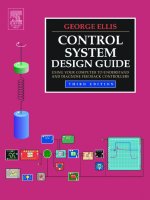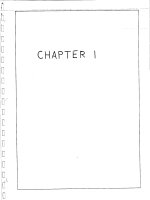CPlusPlus plus data structures, 3rd ed nell dale
Bạn đang xem bản rút gọn của tài liệu. Xem và tải ngay bản đầy đủ của tài liệu tại đây (10.27 MB, 1,296 trang )
C++PlusDataStructures,
ThirdEdition
byNellDale ISBN:0763704814
JonesandBartlettPublishers
©2003(816pages)
Thisbookfocusesonabstract
datatypesasviewedfrom
threedifferentperspectives:
theirspecification,their
application,andtheir
implementation.
TableofContents
C++PlusDataStructures,Third
Edition
Preface
SoftwareEngineering
Chapter1 Principles
DataDesignand
Chapter2 Implementation
ADTsUnsortedListand
Chapter3 SortedList
Chapter4 - ADTsStackandQueue
Chapter5 - LinkedStructures
Chapter6 - ListsPlus
Programmingwith
Chapter7 Recursion
Chapter8
- BinarySearchTrees
PriorityQueues,Heaps,
Chapter9 Graphs,andSets
SortingandSearching
Chapter10 Algorithms
AnswerstoSelectedExercises
AppendixA - ReservedWords
AppendixB - OperatorPrecedence
ASelectionofStandard
AppendixC LibraryRoutines
AppendixD - CharacterSets
TheStandardTemplate
AppendixE Library
Glossary
Index
ListofFigures
ListofTables
ListofC++Examples
ListofSidebars
BackCover
C++PlusDataStructuresisdesignedforacoursein
DataStructureswhereC++istheprogramming
language.Thebookfocusesonabstractdatatypesas
viewedfromthreedifferentperspectives:their
specification,theirapplication,andtheir
implementation.Theauthorsstresscomputerscience
theoryandsoftwareengineeringprinciples,including
modularization,dataencapsulation,informationhiding,
dataabstraction,object-orienteddecomposition,
functionaldecomposition,theanalysisofalgorithms,
andlife-cyclesoftwareverificationmethods.Finally,
throughclassicDalepedagogystudentsareoffereda
clear,easy-to-understanddiscussionofimportant
theoreticalconstructsandtheirimplementationin
C++.
C++PlusDataStructures,ThirdEdition
NellDaleUniversityofTexas,
Austin
JONESANDBARTLETTPUBLISHERS
Sudbury,MassachusettsBOSTONTORONTOLONDONSINGAPORE
WorldHeadquarters
JonesandBartlettPublishers
40TallPineDrive
Sudbury,MA01776
978-443-5000
<>
www.jbpub.com
JonesandBartlettPublishersCanada
2406NikannaRoad
Mississauga,ONL5C2W6
CANADA
JonesandBartlettPublishersInternational
BarbHouse,BarbMews
LondonW67PA
UK
Copyright©2003byJonesandBartlettPublishers,Inc.
Coverimage©DouglasE.Walker/Masterfile
Allrightsreserved.Nopartofthematerialprotectedbythiscopyright
noticemaybereproducedorutilizedinanyform,electronicor
mechanical,includingphotocopying,recording,oranyinformation
storageorretrievalsystem,withoutwrittenpermissionfromthecopyright
owner.
ChiefExecutiveOfficer:ClaytonJones
ChiefOperatingOfficer:DonW.Jones,Jr.
ExecutiveV.P.andPublisher:RobertHolland
V.P.,DesignandProduction:AnneSpencer
V.P.,ManufacturingandInventoryControl:ThereseBräuer
Editor-in-Chief,College:J.MichaelStranz
ProductionManager:AmyRose
MarketingManager:NathanSchultz
AssociateProductionEditor:KarenFerreira
EditorialAssistant:TheresaDiDonato
ProductionAssistant:JennyMclsaac
CoverDesign:Night&DayDesign
Composition:NortheastCompositors,Inc.
TextDesign:AnneSpencer
PrintingandBinding:CourierWestford
CoverPrinting:LehighPress
LibraryofCongressCataloging-in-PublicationData
Dale,NellB.
C++plusdatastructures/NellDale.-3rded.
p.cm.
ISBN0-7637-0481-4
1.C++(Computerprogramlanguage)2.Datastructures(Computer
science)I.Title.
QA76.73.C153D3342003
005.7'3-dc21
2002034168
ThisbookwastypesetinQuark4.1onaMacintoshG4.Thefontfamilies
usedwereRotisSansSerif,RotisSerif,andPrestigeElite.Thefirst
printingwasprintedon45#HighlandBook.
PrintedintheUnitedStatesofAmerica
060504030210987654321
ToAl,myhusbandandbestfriend,toourchildrenandourchildren's
children,andtoourdogsMaggieandChrissie,whoroundoutourfamily.
N.D.
Preface
Historically,acourseondatastructureshasbeenamainstayofmost
computersciencedepartments.Overthelast18years,however,the
focusofthiscoursehasbroadenedconsiderably.Thetopicofdata
structureshasnowbeensubsumedunderthebroadertopicofabstract
datatypes(ADTs)-thestudyofclassesofobjectswhoselogicalbehavior
isdefinedbyasetofvaluesandasetofoperations.
Thetermabstractdatatypedescribesacomprehensivecollectionofdata
valuesandoperations;thetermdatastructuresreferstothestudyofdata
andhowtorepresentdataobjectswithinaprogram;thatis,the
implementationofstructuredrelationships.Theshiftinemphasisis
representativeofthemovetowardsmoreabstractionincomputerscience
education.Wenowareinterestedinthestudyoftheabstractproperties
ofclassesofdataobjectsinadditiontohowtheobjectsmightbe
representedinaprogram.JohannesJ.Martinputitsuccinctly:"...
dependingonthepointofview,adataobjectischaracterizedbyitstype
(fortheuser)orbyitsstructure(fortheimplementor)."[1]
ThreeLevelsofAbstraction
Thefocusofthisbookisonabstractdatatypesasviewedfromthree
differentperspectives:theirspecification,theirapplication,andtheir
implementation.Thespecificationperspectivedescribesthelogicalor
abstractlevelofdatatypes,andisconcernedwithwhattheoperations
do.Theapplicationlevel,sometimescalledtheuserlevel,isconcerned
withhowthedatatypemightbeusedtosolveaproblem,andisfocused
onwhytheoperationsdowhattheydo.Theimplementationlevelis
wheretheoperationsareactuallycoded.Thislevelisconcernedwiththe
howquestions.
Withinthisfocus,westresscomputersciencetheoryandsoftware
engineeringprinciples,includingmodularization,dataencapsulation,
informationhiding,dataabstraction,object-orienteddecomposition,
functionaldecomposition,theanalysisofalgorithms,andlife-cycle
softwareverificationmethods.Wefeelstronglythattheseprinciples
shouldbeintroducedtocomputersciencestudentsearlyintheir
educationsothattheylearntopracticegoodsoftwaretechniquesfrom
thebeginning.
Anunderstandingoftheoreticalconceptshelpsstudentsputthenew
ideastheyencounterintoplace,andpracticaladviceallowsthemto
applywhattheyhavelearned.Toteachtheseconceptstostudentswho
maynothavecompletedmanycollege-levelmathematicscourses,we
consistentlyuseintuitiveexplanations,evenfortopicsthathaveabasis
inmathematics,liketheanalysisofalgorithms.Inallcases,ourhighest
goalhasbeentomakeourexplanationsasreadableandaseasily
understandableaspossible.
[1]JohannesJ.Martin,DataTypesandDataStructures,Prentice-Hall
InternationalSeriesinComputerScience,C.A.R.Hoare,SeriesEditor,
Prentice-HallInternational,(UK),LTD,1986,p.1.
PrerequisiteAssumptions
Inthisbook,weassumethatstudentsarefamiliarwiththefollowingC++
constructs:
Built-insimpledatatypes
StreamI/Oasprovidedin<iostream>
StreamI/Oasprovidedin<fstream>
Controlstructureswhile,do-while,for,if,andswitch
User-definedfunctionswithvalueandreferenceparameters
Built-inarraytypes
Classconstruct
Wehaveincludedsidebarswithinthetexttorefreshstudents'memory
concerningsomeofthedetailsofthesetopics.
ChangesintheThirdEdition
Thethirdeditionincorporatesthefollowingchanges:
Object-orientedconstructsmovedforward:Inthelastfiveyears,objectorientedprogramminghasbecomepartofthefirst-yearcurriculum,as
demonstratedbyitsinclusioninallvariationsofthefirstyearoutlinedin
theComputingCurricula2001developedbytheJointTaskForceofthe
IEEEComputerSocietyandtheAssociationforComputingMachinery.
Accordingly,theclassconcepthasmovedintothefirstsemester.
Becauseofthis,weassumethatstudentshavehadexperienceusing
classes,andwethereforemovedmuchofthediscussionofhowtodefine
andaccessclassestoasidebar.Wehavekeptasmalldiscussioninthe
maintext.Manystudentshavealreadyseeninheritanceand
polymorphism,buttheconceptsaretooimportanttomovetoasidebar,
sowehavemovedthemfromChapter6toChapter2.
Moreemphasisonobject-orienteddesign:Object-orienteddesignisa
hardtopicformoststudents,becausepeopleusuallythinkprocedurallyin
theirlives.Becauseofthis,weintroduceamethodologywithfourphases:
brainstorming,duringwhichthepossibleobjectsinaproblemare
isolated;filtering,duringwhichthesetofpossibleobjectsarereexamined
tolookforduplicatesand/ormissingobjects;scenarios,duringwhich
handsimulationsoftheprocessingtakeplaceasking"whatif"questions
andassigningresponsibilitiestoclasses;andresponsibilityalgorithms,
duringwhichthealgorithmsfortheclassesaredesigned.WeuseCRC
cardstocapturetheresultsofthefour-phaseprocess.Theoutputfrom
thescenariosphaseisaCRCcardforeachclass.TheCRCcardliststhe
responsibilitiesoftheclassandanyotherclasseswithwhichtheclass
mustcollaborate,hencethenameCRC:class,responsibility,
collaboration.
Morepracticalemphasisontesting:Theconceptofamultipurposetest
driverisintroducedinChapter1.Afteratestplanhasbeendesigned,itis
implementedasinputtothetestdriver.Throughouttherestofthebook,
thistechniqueisusedtotesttheADTs.Thedrivers,theinputdata,and
theoutputdataareavailableonthebook'swebsite:
/>Reduceduseoftemplates:Theconceptofgenericdatatypes,as
implementedinC++usingtemplates,isveryimportant.Makingevery
ADTaclasstemplateaftertemplatesareintroducedinChapter4,
however,insertsanunnecessarycomplexityintoalreadycomplexcode.
Thus,whenintroducinganewconstructsuchasalinkedlistorabinary
searchtree,wehavechosentouseclassesratherthanclasstemplates.
Subsequentimplementationsofaconstructareoftenintheformofclass
templates,orthestudentisaskedtotransformaclassintoaclass
templateintheexercises.
Nonlinkedbinarytreerepresentationcoveredwithbinarytrees:The
nonlinkedrepresentationofabinarytreeisanimportantconceptwithin
itsownright,notjustasanimplementationforaheap.This
implementation,therefore,iscoveredinChapter8withothertree
implementationtechniques.
Removalofmaterialonbinaryexpressiontrees:Althoughinteresting
applicationsoftrees,binaryexpressiontreesdonotfitintothediscussion
ofabstractdatatypes.Thus,wehavemovedthisdiscussiontotheweb
site.
InclusionoftheADTset:TheexclusionoftheADTsethasbeenan
omissionfrompreviouseditions.Notonlyisasetaninteresting
mathematicalobject,butthereareinterestingimplementationissues.We
proposetwoimplementations,oneexplicit(bitvector)andoneimplicit
(list-based).
ContentandOrganization
Chapter1outlinesthebasicgoalsofhigh-qualitysoftware,andthebasic
principlesofsoftwareengineeringfordesigningandimplementing
programstomeetthesegoals.Abstraction,functionaldecomposition,
andobject-orienteddesignarediscussed.Thischapteralsoaddresses
whatweseeasacriticalneedinsoftwareeducation:theabilitytodesign
andimplementcorrectprogramsandtoverifythattheyareactually
correct.Topicscoveredincludetheconceptof"life-cycle"verification;
designingforcorrectnessusingpreconditionsandpostconditions;theuse
ofdeskcheckinganddesign/codewalkthroughsandinspectionsto
identifyerrorsbeforetesting;debuggingtechniques,datacoverage
(black-box),andcodecoverage(clear-orwhite-box)approaches;test
plans,unittesting,andstructuredintegrationtestingusingstubsand
drivers.Theconceptofageneralizedtestdriverispresentedand
executedinaCaseStudythatdevelopstheADTFraction.
Chapter2presentsdataabstractionandencapsulation,thesoftware
engineeringconceptsthatrelatetothedesignofthedatastructuresused
inprograms.Threeperspectivesofdataarediscussed:abstraction,
implementation,andapplication.Theseperspectivesareillustratedusing
areal-worldexample,andthenareappliedtobuilt-indatastructuresthat
C++supports:structsandarrays.TheC++classtypeispresentedasthe
waytorepresenttheabstractdatatypesweexamineinsubsequent
chapters.Theprinciplesofobject-orientedprogramming-encapsulation,
inheritance,andpolymorphism-areintroducedherealongwiththe
accompanyingC++implementationconstructs.TheCaseStudyatthe
endofthischapterreinforcestheideasofdataabstractionand
encapsulationindesigningandimplementingauser-defineddatatypefor
generalizedstringinputandoutput.Thisclassistestedusingaversionof
thegeneralizedtestdriver.
Chapter2endswithadiscussionoftwoC++constructsthathelpusers
writebettersoftware:namespaceandexceptionhandlingusingthe
try/catchstatement.Variousapproachestoerrorhandlingare
demonstratedinsubsequentchapters.
WewouldliketothinkthatthematerialinChapters1and2isareview
formoststudents.Theconceptsinthesetwochapters,however,areso
crucialtothefutureofanyandallstudentsthatwefeelthatwecannot
relyontheassumptionthattheyhaveseenthematerialbefore.
Chapter3introducesthemostfundamentalabstractdatatypeofall:the
list.Thechapterbeginswithageneraldiscussionofoperationson
abstractdatatypesandthenpresentstheframeworkwithwhichallofthe
otherdatatypesareexamined:apresentationanddiscussionofthe
specification,abriefapplicationusingtheoperations,andthedesignand
codingoftheoperations.Boththeunsortedandthesortedlistsare
presentedwithanarray-basedimplementation.Overloadingtherelational
operatorsispresentedasawaytomaketheimplementationsmore
generic.Thebinarysearchisintroducedasawaytoimprovethe
performanceofthesearchoperationinthesortedlist.Becausethereis
morethanonewaytosolveaproblem,wediscusshowcompeting
solutionscanbecomparedthroughtheanalysisofalgorithms,usingBigOnotation.Thisnotationisthenusedtocomparetheoperationsinthe
unsortedlistandthesortedlist.Thefour-phaseobject-oriented
methodologyispresentedanddemonstratedintheCaseStudybyusing
asimplerealestatedatabase.
Chapter4introducesthestackandthequeuedatatypes.Eachdatatype
isfirstconsideredfromitsabstractperspective,andtheideaofrecording
thelogicalabstractioninanADTspecificationisstressed.Thenthesetof
operationsisimplementedinC++usinganarray-basedimplementation.
Theconceptofdynamicallocationisintroduced,alongwiththesyntaxfor
usingC++pointervariables,andthenusedtodemonstratehowarrays
canbedynamicallyallocatedtogivetheusermoreflexibility.Withthe
introductionofdynamicstorage,thedestructormustbeintroduced.
Templatesareintroducedasawayofimplementinggenericclasses.A
CaseStudyusingstacks(postfixexpressionevaluator)andoneusing
queues(simulation)arepresented.
Chapter5reimplementstheADTsfromChapters3and4aslinked
structures.Thetechniqueusedtolinktheelementsindynamically
allocatedstorageisdescribedindetailandillustratedwithfigures.The
array-basedimplementationsandthelinkedimplementationsarethen
comparedusingBig-Onotation.
Chapter6isacollectionofadvancedconceptsandtechniques.Circular
linkedlistsanddoublylinkedlistsarediscussed.Theinsertion,deletion,
andlisttraversalalgorithmsaredevelopedandimplementedforeach
variation.Analternativerepresentationofalinkedstructure,usingstatic
allocation(anarrayofstructs),isdesigned.Classcopyconstructors,
assignmentoverloading,anddynamicbindingarecoveredindetail.The
CaseStudyusesdoublylinkedliststoimplementlargeintegers.
Chapter7discussesrecursion,givingthestudentanintuitive
understandingoftheconcept,andthenshowshowrecursioncanbe
usedtosolveprogrammingproblems.Guidelinesforwritingrecursive
functionsareillustratedwithmanyexamples.Afterdemonstratingthata
by-handsimulationofarecursiveroutinecanbeverytedious,asimple
three-questiontechniqueisintroducedforverifyingthecorrectnessof
recursivefunctions.Becausemanystudentsarewaryofrecursion,the
introductiontothismaterialisdeliberatelyintuitiveandnonmathematical.
Amoredetaileddiscussionofhowrecursionworksleadstoan
understandingofhowrecursioncanbereplacedwithiterationand
stacks.TheCaseStudydevelopsandimplementstheQuick-Sort
algorithm.
Chapter8introducesbinarysearchtreesasawaytoarrangedata,giving
theflexibilityofalinkedstructurewithO(log2N)insertionanddeletion
time.Inordertobuildonthepreviouschapterandexploittheinherent
recursivenatureofbinarytrees,thealgorithmsfirstarepresented
recursively.Afteralltheoperationshavebeenimplementedrecursively,
wecodetheinsertionanddeletionoperationsiterativelytoshowthe
flexibilityofbinarysearchtrees.Anonlinkedarray-basedbinarytree
implementationisdescribed.TheCaseStudydiscussestheprocessof
buildinganindexforamanuscriptandimplementsthefirstphase.
Chapter9presentsacollectionofotherbranchingstructures:priority
queues(implementedwithbothlistsandheaps),graphs,andsets.The
graphalgorithmsmakeuseofstacks,queues,andpriorityqueues,thus
bothreinforcingearliermaterialanddemonstratinghowgeneralthese
structuresare.Twosetimplementationsarediscussed:thebit-vector
representation,inwhicheachiteminthebasesetisassigneda
present/absentflagandtheoperationsarethebuilt-inlogicoperations,
andalist-basedrepresentation,inwhicheachiteminasetis
representedinalistofsetitems.Iftheitemisnotinthelist,itisnotinthe
set.
Chapter10presentsanumberofsortingandsearchingalgorithmsand
asksthequestion:Whicharebetter?Thesortingalgorithmsthatare
illustrated,implemented,andcomparedincludestraightselectionsort,
twoversionsofbubblesort,quicksort,heapsort,andmergesort.The
sortingalgorithmsarecomparedusingBig-Onotation.Thediscussionof
algorithmanalysiscontinuesinthecontextofsearching.Previously
presentedsearchingalgorithmsarereviewedandnewonesare
described.Hashingtechniquesarediscussedinsomedetail.Finally,
radixsortispresentedandanalyzed.
AdditionalFeatures
ChapterGoalsAsetofgoalspresentedatthebeginningofeachchapter
helpsthestudentsassesswhattheywilllearn.Thesegoalsaretestedin
theexercisesattheendofeachchapter.
ChapterExercisesMostchaptershavemorethan35exercises.They
varyinlevelsofdifficulty,includingshortprogrammingproblems,the
analysisofalgorithms,andproblemstotestthestudent'sunderstanding
ofconcepts.Approximatelyone-thirdoftheexercisesareansweredin
thebackofthebook.Theanswerkeyfortheremainingexercisesisin
theInstructor'sGuide.
CaseStudiesTherearesevencasestudies.Eachincludesaproblem
description,ananalysisoftheprobleminputandrequiredoutput,anda
discussionoftheappropriatedatatypestouse.Severalofthecase
studiesarecompletelycodedandtested.Othersareleftatvarious
stagesintheirdevelopment,requiringthestudenttocompleteandtest
thefinalversion.
ProgramDiskThespecificationandimplementationofeachclass
representinganADTisavailableonaprogramdiskthatcanbe
downloaded,freeofcharge,fromtheJonesandBartlettStudentDiskette
PageontheWorldWideWeb(www.jbpub.com/disks).Thesource
codeforthecompletedcasestudiesandthepartialsourcecodeforthe
othersisalsoavailable.
InstructorSupportMaterialInstructorteachingtoolsandresourcesare
availableonthewebat
Onthissite
youwillfind:
Goals
Outlines
TeachingNotes:suggestionsforhowtoteachthematerial
coveredineachchapter
Workouts:suggestionsforin-classactivities,discussion
questions,andshortexercises
ExerciseKey:answerstothosequestionsthatarenotsolvedin
thebackofthebook
ProgrammingAssignments:acollectionofawiderangeof
assignmentscarefullychosentoillustratethetechniques
describedinthetext
ElectronicTestBank:thiscomputerizedTestBankallowsyouto
createcustomizedexamsorquizzesfromacollectionofpremadequestionssortedbychapter.Updatedforthisedition,the
TestBankquestionscanbeeditedandsupplemented,and
answersareprovidedforallpre-madequestions.Eachtestis
developedusingBrownstoneDiplomaSoftwareandisavailable
onthebook'swebsite.
PowerPointPresentations:newPowerPointslidesdeveloped
specificallyforthethirdeditionprovideanexcellentvisual
accompanimenttolectures.ThePowerPointpresentationsfor
eachchapteraredesignedtocoordinatewiththematerialinthe
textbook,andcanbedownloadedfromthebook'swebsite.
Acknowledgments
Wewouldliketothankthefollowingpeoplewhotookthetimetoreview
thefirsteditionofthismanuscript:DonaldBagert,TexasTechUniversity;
SusanGauch,UniversityofKansas;PamelaLawhead,Universityof
Mississippi;PatNettnin,FingerLakesCommunityCollege;Bobbie
Othmer,WestminsterCollegeofSaltLakeCity;SuzannePawlan-Levy,
AllanHancockCollege;CarolRoberts,UniversityofMaine;andRobert
Strader,StephenF.AustinStateUniversity.Thanksalsotoallofyouwho
tookthetimetoanswerourelectronicsurveyconcerningthisthird
edition.
AspecialthankstoJohnMcCormick,UniversityofNorthernIowa,Mark
Headington,UniversityofWisconsin-LaCrosse,andDanJoyce.Johnand
DangraciouslyallowedustousesomeoftheiranalogiesfromAdaPlus
DataStructuresandObject-OrientedDataStructuresUsingJava,
respectively.Mark'sideas,suggestions,andsharpeyeswereinvaluable.
ThanksalsotothestudentsatUppsalaUniversityinSwedenwhoused
thefinaldraftofthemanuscriptofthesecondeditioninacourseinthe
fallof1997.Becausenon-Englishreadersseewhatiswritten,notwhat
theyexpecttosee,theircommentswereinvaluableincleaningup
ambiguouswording.
ThankstomyhusbandAl,ourchildrenandgrandchildrentoonumerous
toname,andourdogs,Maggie,whokeepsmyfeetwarm,andChrissie,
whoseroleinlifeistokeepthehouseinturmoilandmud.
Avirtualbouquetofrosestothepeoplewhohaveworkedonthisbook:
MikeandSigridWile,alongwithourJonesandBartlettfamily.Theresa
DiDonato,ajack-of-all-tradeswhohelpedwiththesurvey;Jenny
Mclsaac,whojumpeddirectlyintothefryingpanonherfirstday;Nathan
Schultz,whose"cando"attitudeisajoytoworkwith;andMichaelStranz
andAmyRose,whoseteameffortsustainsallofus.Amy,thankheavens
thisproductionschedulewasalittlemoreleisurelythanthelast-butnot
bymuch!
N.D.
Chapter1:SoftwareEngineeringPrinciples
Goals
Afterstudyingthischapter,youshouldbeableto
Describethegeneralactivitiesinthesoftwarelifecycle
Describethegoalsfor"quality"software
Explainthefollowingterms:softwarerequirements,software
specifications,algorithm,informationhiding,abstraction,stepwise
refinement
Explainandapplythefundamentalideasoftop-downdesign
Explainandapplythefundamentalideasofobject-oriented
design
Identifyseveralsourcesofprogramerrors
Describestrategiestoavoidsoftwareerrors
Specifythepreconditionsandpostconditionsofaprogram
segmentorfunction
Showhowdeskchecking,codewalk-throughs,anddesignand
codeinspectionscanimprovesoftwarequalityandreducethe
softwaredevelopmenteffort
Explainthefollowingterms:acceptancetests,regressiontesting,
verification,validation,functionaldomain,black-boxtesting,
white-boxtesting
Stateseveraltestinggoalsandindicatewheneachwouldbe
appropriate
Describeseveralintegration-testingstrategiesandindicatewhen
eachwouldbeappropriate
Explainhowprogramverificationtechniquescanbeapplied
throughoutthesoftwaredevelopmentprocess
CreateaC++testdriverprogramtotestasimpleclass
Atthispointinyourcomputingcareer,youhavecompletedatleastone
semesterofcomputersciencecoursework.Youcantakeaproblemof
mediumcomplexity,writeanalgorithmtosolvetheproblem,codethe
algorithminC++,anddemonstratethecorrectnessofyoursolution.At
least,that'swhatthesyllabusforyourintroductoryclasssaidyoushould
beabletodowhenyoucompletethecourse.Nowthatyouarestarting
yoursecond(orthird?)semester,itistimetostopandreviewthose
principlesthat,ifadheredto,guaranteethatyoucanindeeddowhatyour
previoussyllabusclaimed.
Inthischapter,wereviewthesoftwaredesignprocessandthe
verificationofsoftwarecorrectness.InChapter2,wereviewdatadesign
andimplementation.
1.1TheSoftwareProcess
Whenweconsidercomputerprogramming,weimmediatelythinkof
writingaprogramforacomputertoexecute-thegenerationofcodein
somecomputerlanguage.Asabeginningstudentofcomputerscience,
youwroteprogramsthatsolvedrelativelysimpleproblems.Muchofyour
initialeffortwentintolearningthesyntaxofaprogramminglanguage
suchasC++:thelanguage'sreservedwords,itsdatatypes,its
constructsforselection(if-elseandswitch)andlooping(while,do
while,andfor),anditsinput/outputmechanisms(cinandcout).
Youmayhavelearnedaprogrammingmethodologythattookyoufrom
theproblemdescriptionthatyourinstructorhandedoutalltheway
throughthedeliveryofagoodsoftwaresolution.Programmershave
createdmanydesigntechniques,codingstandards,andtestingmethods
tohelpdevelophigh-qualitysoftware.Butwhybotherwithallthat
methodology?Whynotjustsitdownatacomputerandwriteprograms?
Aren'twewastingalotoftimeandeffort,whenwecouldjustgetstarted
onthe"real"job?
Ifthedegreeofourprogrammingsophisticationneverhadtoriseabove
theleveloftrivialprograms(likesummingalistofpricesoraveraging
grades),wemightgetawaywithsuchacode-firsttechnique(or,rather,
lackoftechnique).Somenewprogrammersworkthisway,hackingaway
atthecodeuntiltheprogramworksmoreorlesscorrectly-usuallyless.
Asyourprogramsgrowlargerandmorecomplex,however,youmustpay
attentiontoothersoftwareissuesinadditiontocoding.Ifyoubecomea
softwareprofessional,somedayyoumayworkaspartofateamthat
developsasystemcontainingtensofthousands,orevenmillions,oflines
ofcode.Theactivitiesinvolvedinsuchasoftwareproject'swhole"life
cycle"clearlygobeyondjustsittingdownatacomputerandwriting
programs.Theseactivitiesinclude
ProblemanalysisUnderstandingthenatureoftheproblemtobe
solved
RequirementselicitationDeterminingexactlywhattheprogram
mustdo
RequirementsdefinitionSpecifyingwhattheprogrammustdo
(functionalrequirements)andanyconstraintsonthesolution
approach(nonfunctionalrequirementssuchaswhatlanguageto
use)
High-andlow-leveldesignRecordinghowtheprogrammeetsthe
requirements,fromthe"bigpicture"overviewtothedetailed
design
ImplementationofthedesignCodingaprograminacomputer
language
TestingandverificationDetectingandfixingerrorsand
demonstratingthecorrectnessoftheprogram
DeliveryTurningoverthetestedprogramtothecustomeroruser
(orinstructor!)
OperationActuallyusingtheprogram
MaintenanceMakingchangestofixoperationalerrorsandtoadd
ormodifytheprogram'sfunction
Softwaredevelopmentisnotsimplyamatterofgoingthroughthese
stepssequentially.Rather,manyactivitiestakeplaceconcurrently.We
maycodeonepartofthesolutionwhilewedesignanotherpart,ordefine
requirementsforanewversionofaprogramwhilewecontinuetesting
thecurrentversion.Oftenanumberofpeoplemayworkondifferentparts
ofthesameprogramsimultaneously.Keepingtrackofalltheseactivities
isnotaneasytask.
Weusethetermsoftwareengineeringtorefertothedisciplineconcerned
withallaspectsofthedevelopmentofhighqualitysoftwaresystems.It
encompassesallvariationsoftechniquesusedduringthesoftwarelife
cycleplussupportingactivitiessuchasdocumentationandteamwork.A
softwareprocessisaspecificsetofinterrelatedsoftwareengineering
techniques,usedbyapersonororganizationtocreateasystem.
SoftwareengineeringThedisciplinedevotedtothedesign,
production,andmaintenanceofcomputerprogramsthatare
developedontimeandwithincostestimates,usingtoolsthathelpto
managethesizeandcomplexityoftheresultingsoftwareproducts
SoftwareprocessAstandard,integratedsetofsoftware
engineeringtoolsandtechniquesusedonaprojectorbyan
organization
Whatmakesourjobsasprogrammersorsoftwareengineerschallenging
isthetendencyofsoftwaretogrowinsizeandcomplexityandtochange
ateverystageofitsdevelopment.Agoodsoftwareprocessusestoolsto
managethissizeandcomplexityeffectively.Usuallyaprogrammertakes
advantageofseveraltoolboxes,eachcontainingtoolsthathelptobuild
andshapeasoftwareproduct.
HardwareOnetoolboxcontainsthehardwareitself:thecomputersand
theirperipheraldevices(suchasmonitors,terminals,storagedevices,
andprinters),onwhichandforwhichwedevelopsoftware.
SoftwareAsecondtoolboxcontainsvarioussoftwaretools:operating
systemstocontrolthecomputer'sresources,texteditorstohelpusenter
programs,compilerstotranslatehigh-levellanguageslikeC++into
somethingthatthecomputercanexecute,interactivedebugging
programs,test-datagenerators,andsoon.You'veusedsomeofthese
toolsalready.
IdeawareAthirdtoolboxisfilledwiththesharedbodyofknowledgethat
programmershavecollectedovertime.Thisboxcontainsthealgorithms
thatweusetosolvecommonprogrammingproblemsaswellasdata
structuresformodelingtheinformationprocessedbyourprograms.
Recallthatanalgorithmisastep-by-stepdescriptionofthesolutiontoa
problem.Howwechoosebetweentwoalgorithmsthatcarryoutthesame
taskoftendependsontherequirementsofaparticularapplication.Ifno
relevantrequirementsexist,thechoicemaybebasedonthe
programmer'sownstyle.









